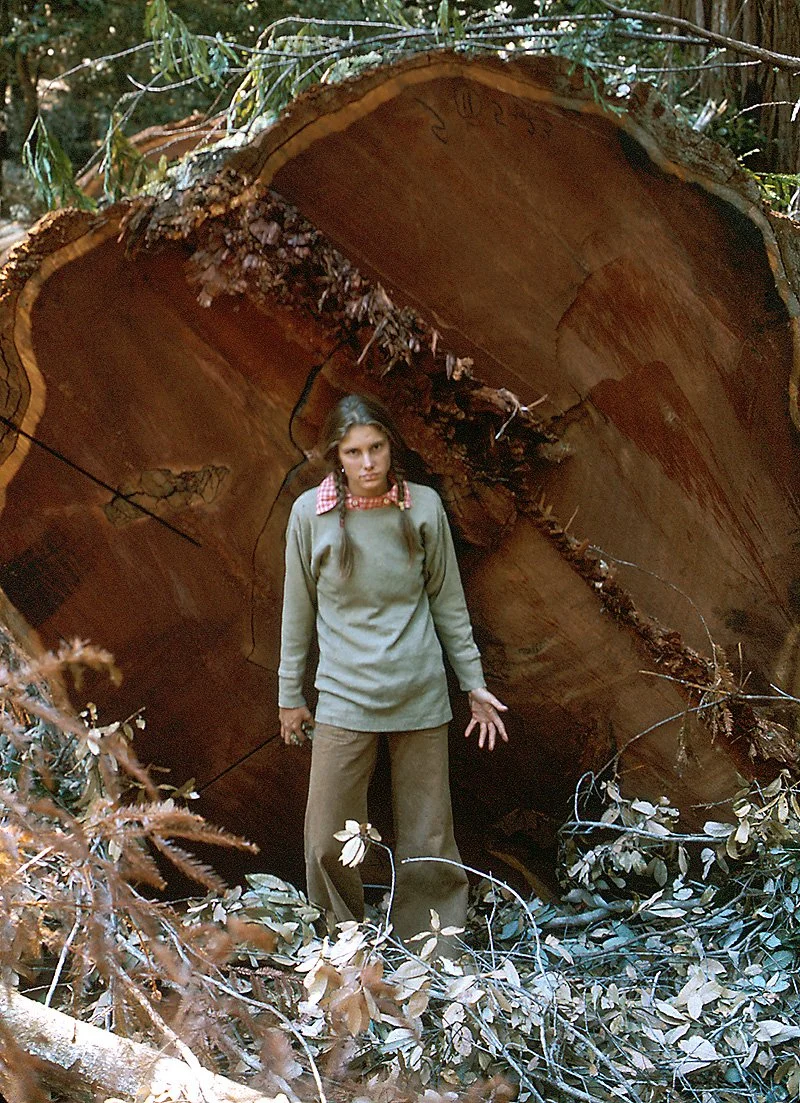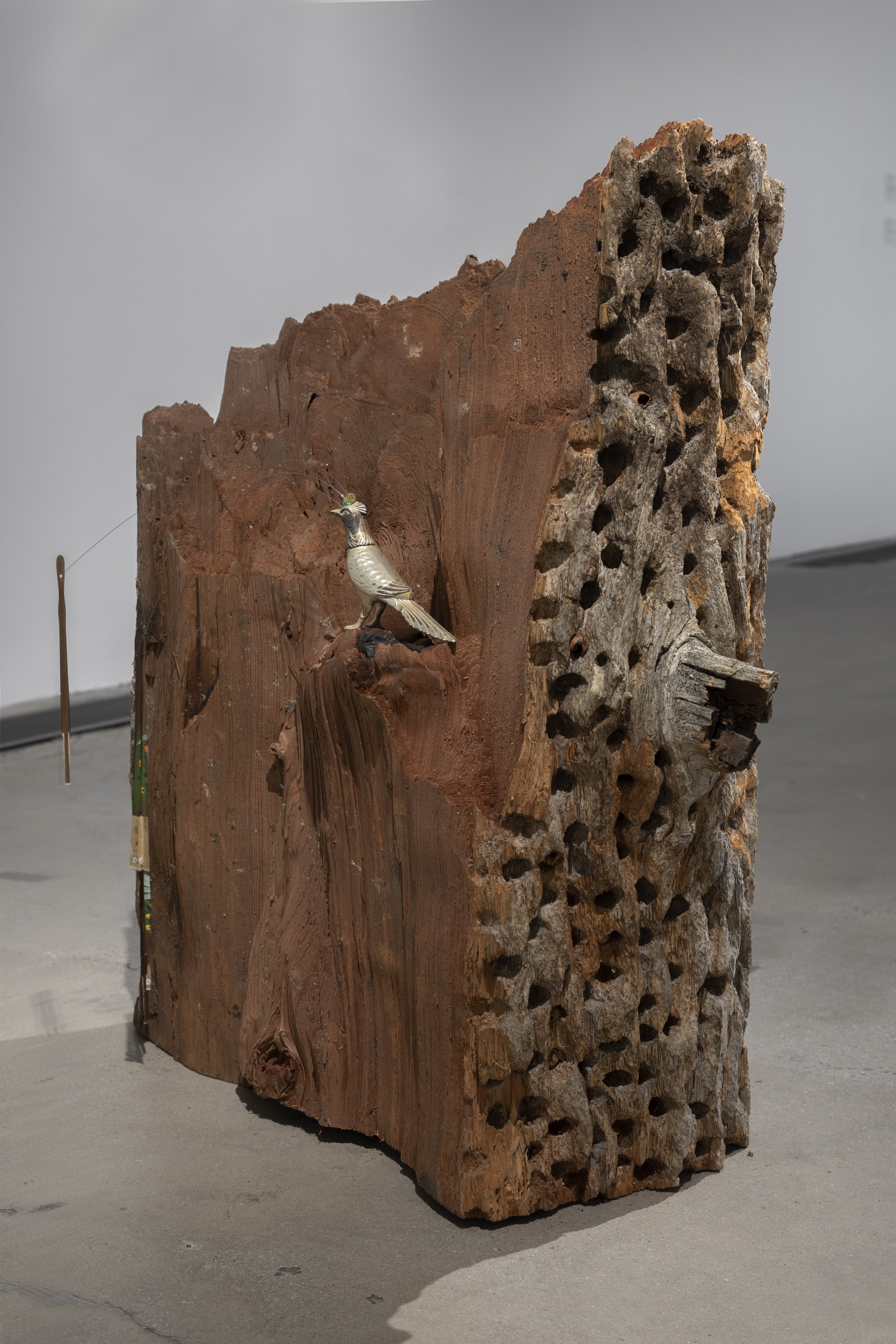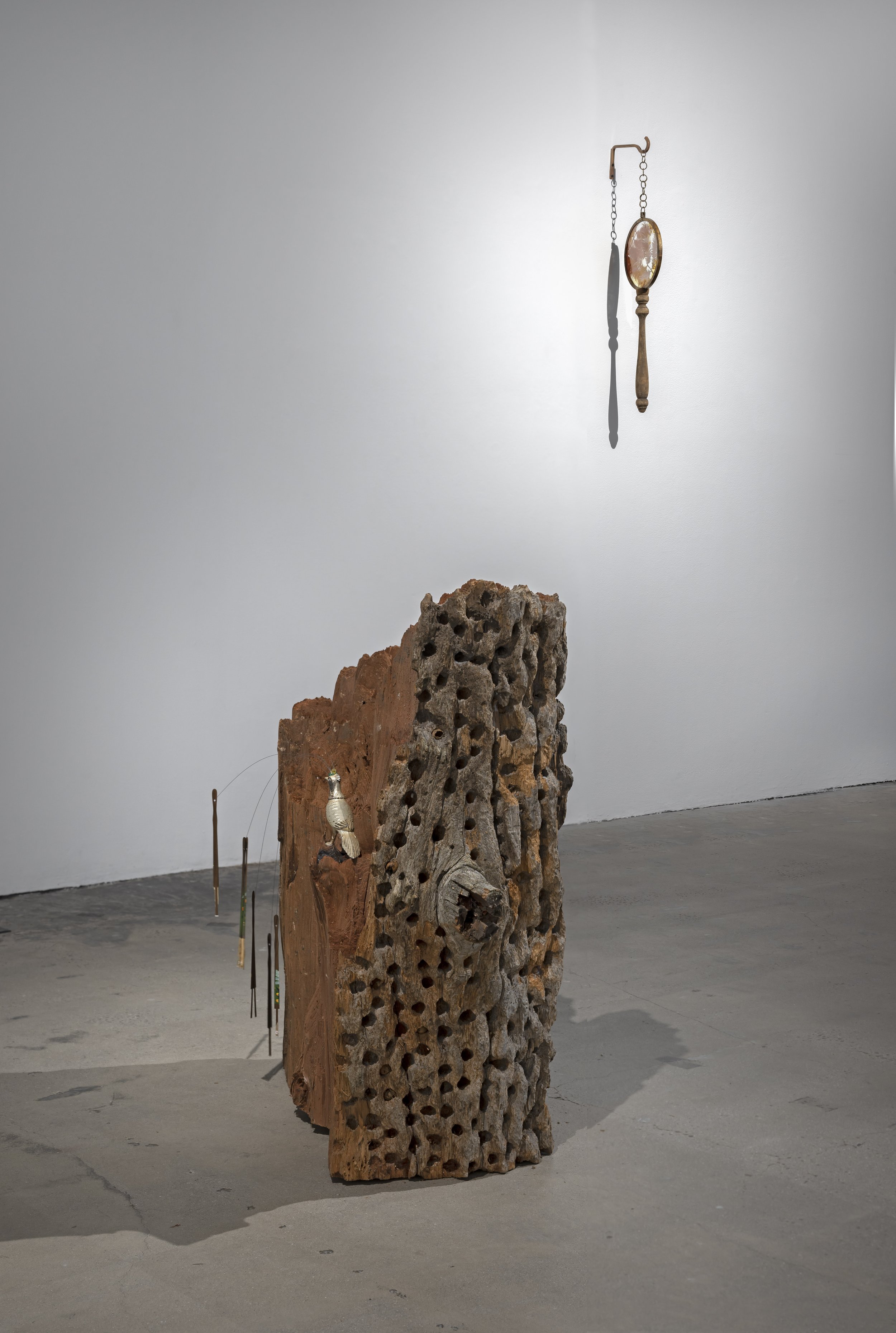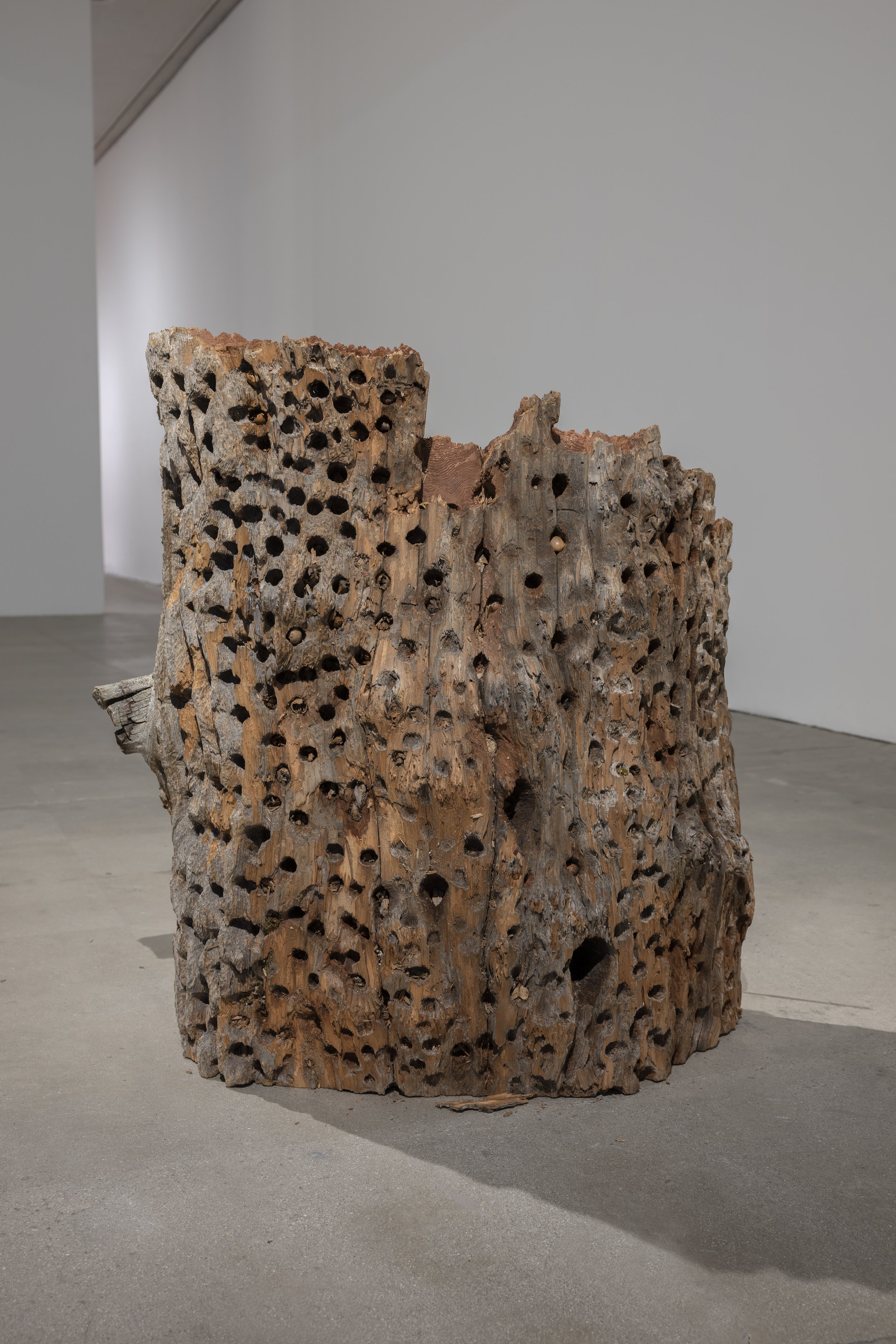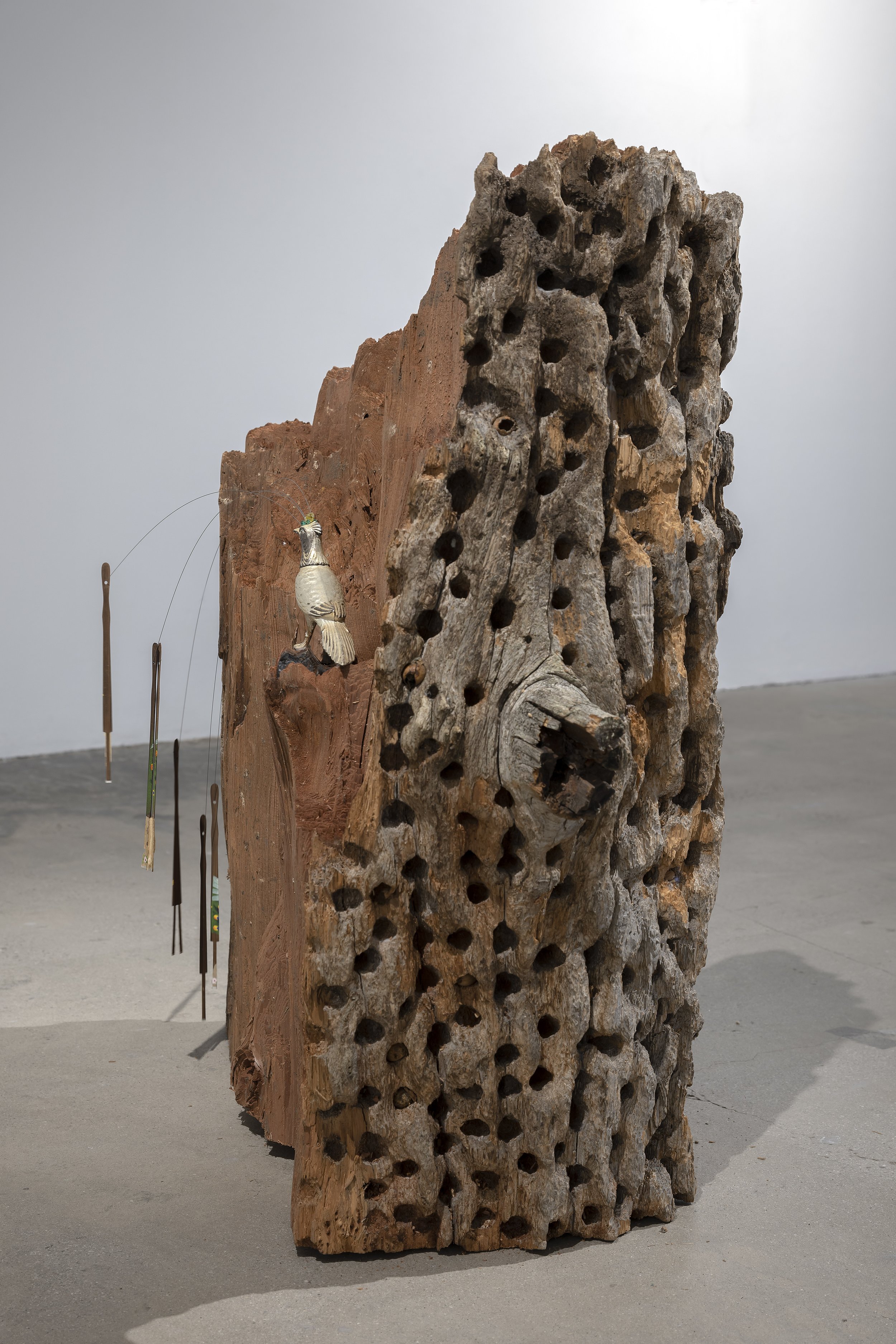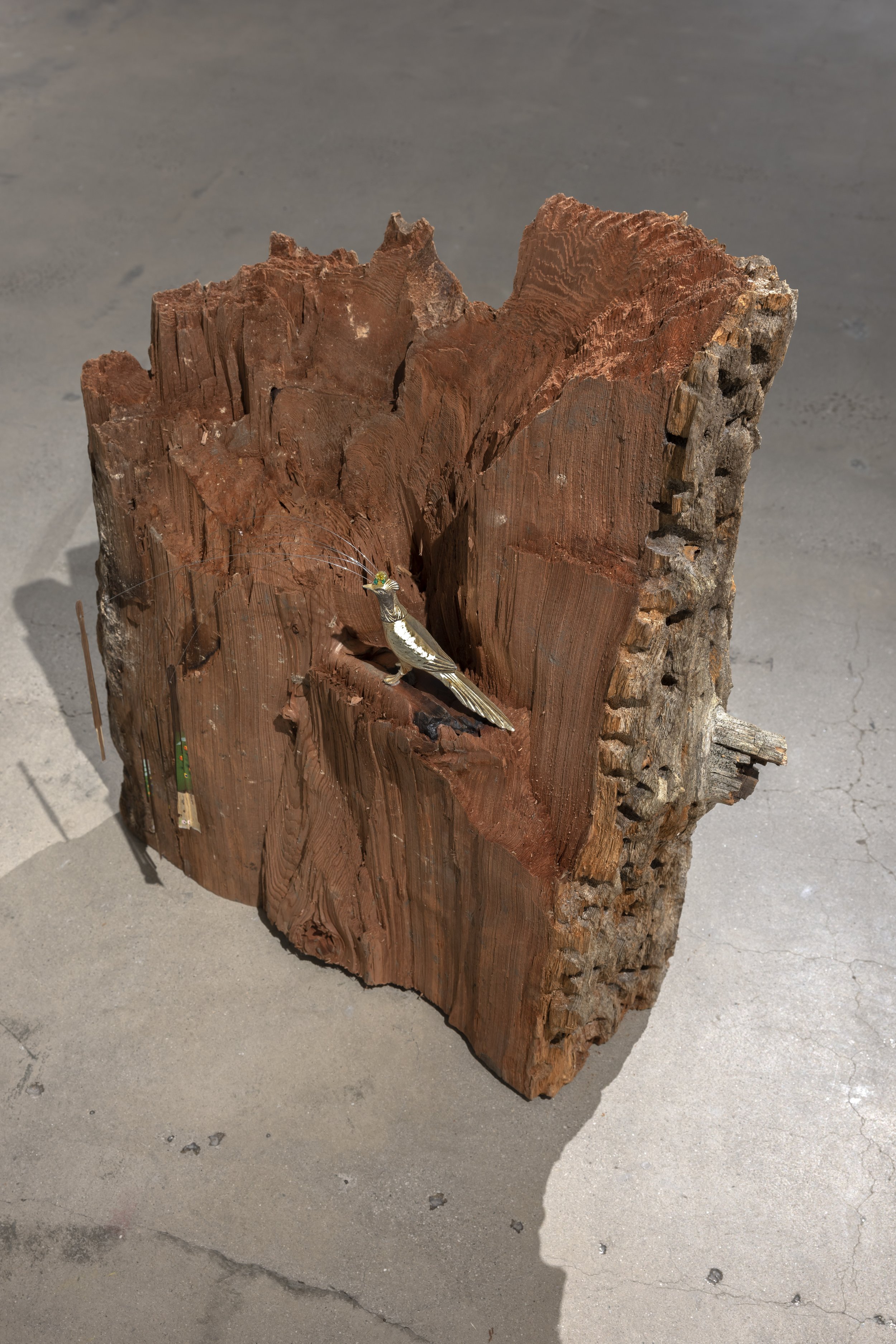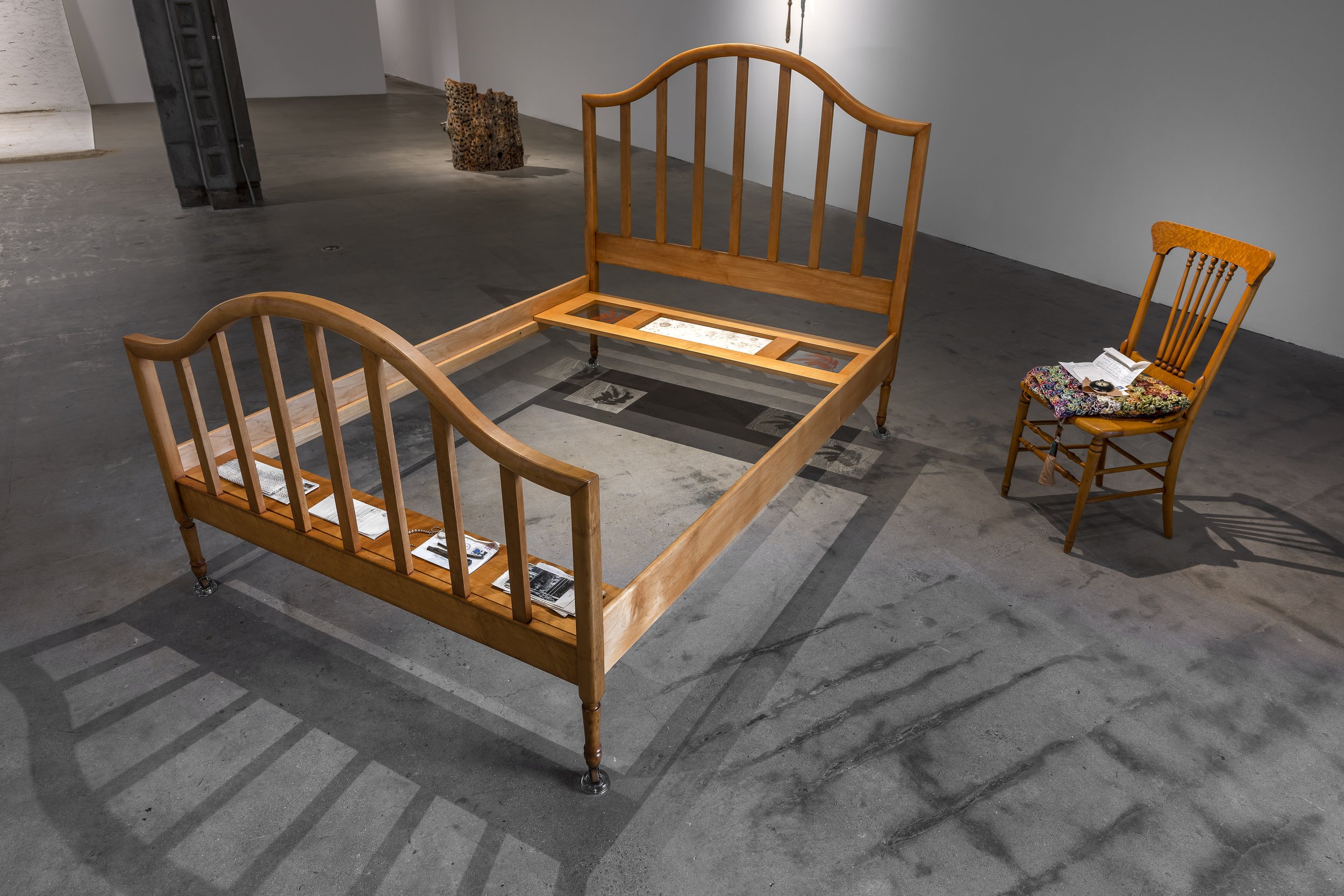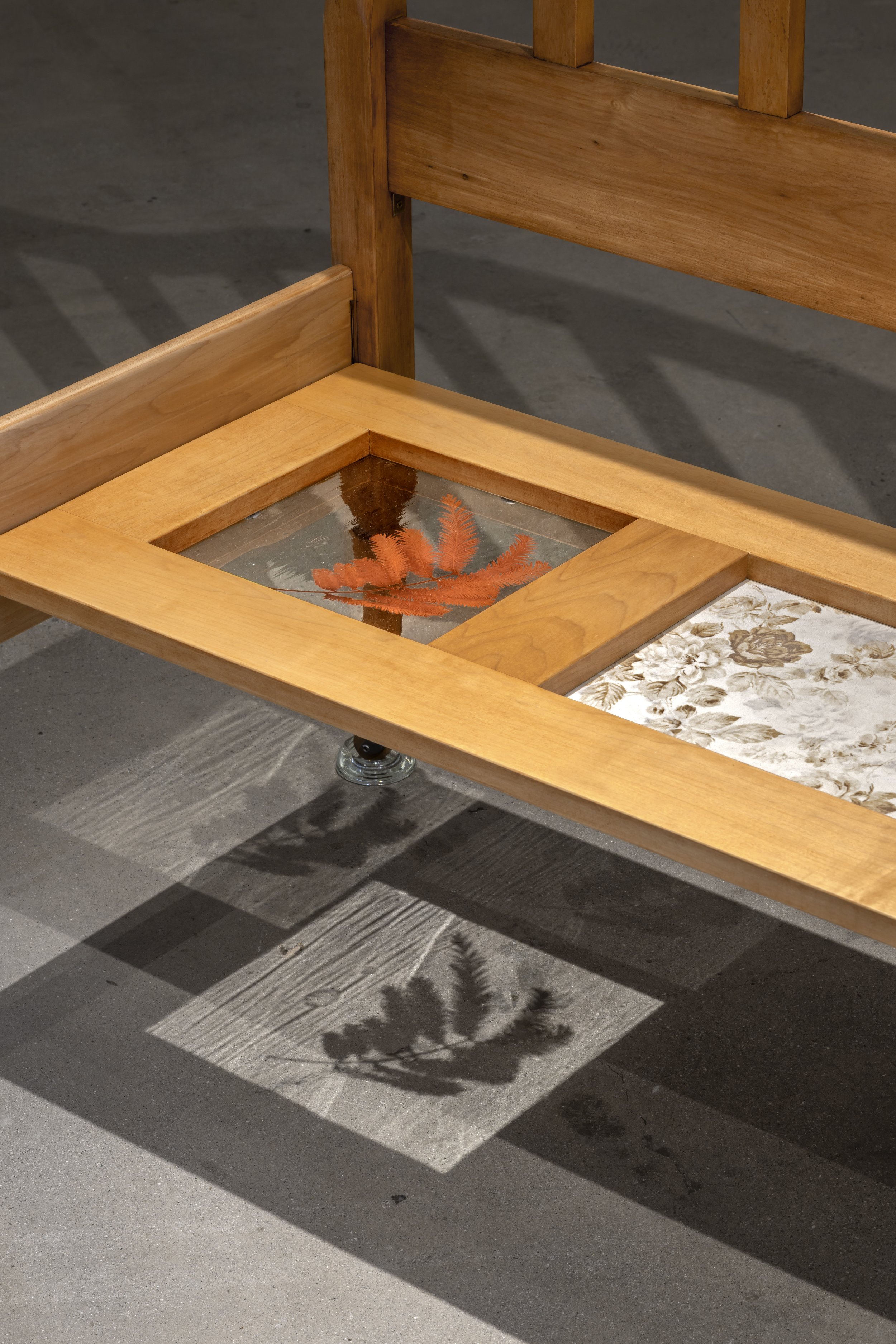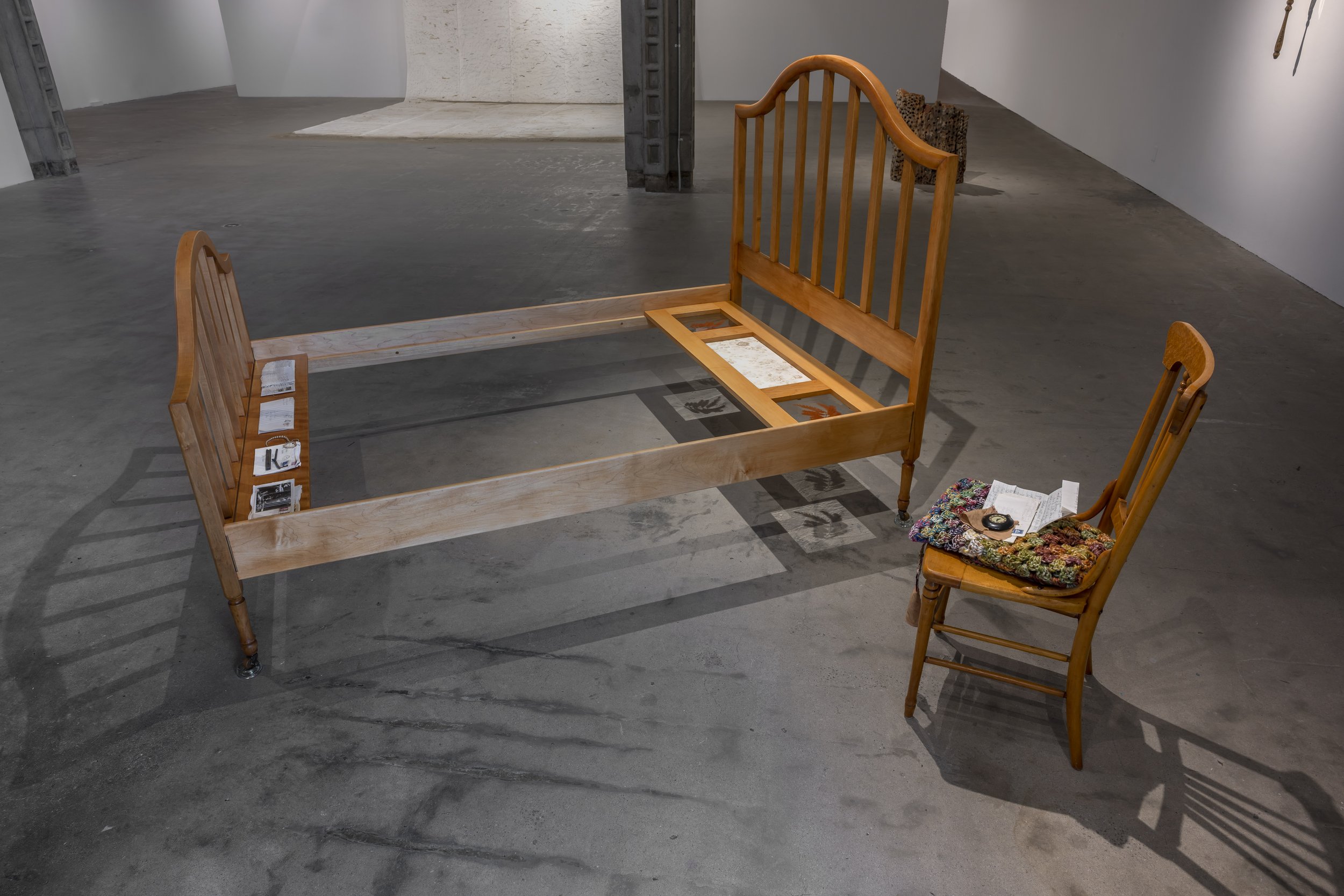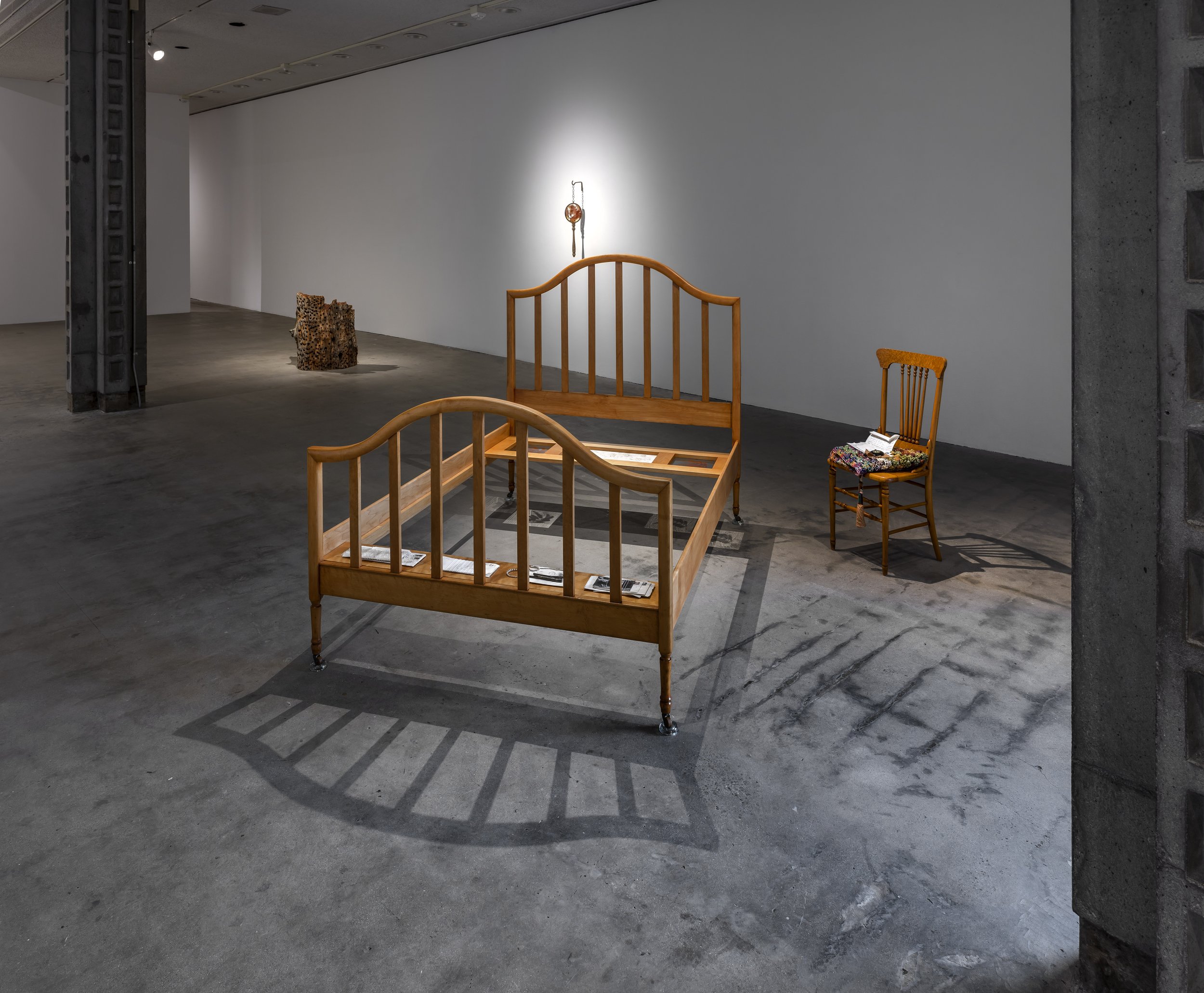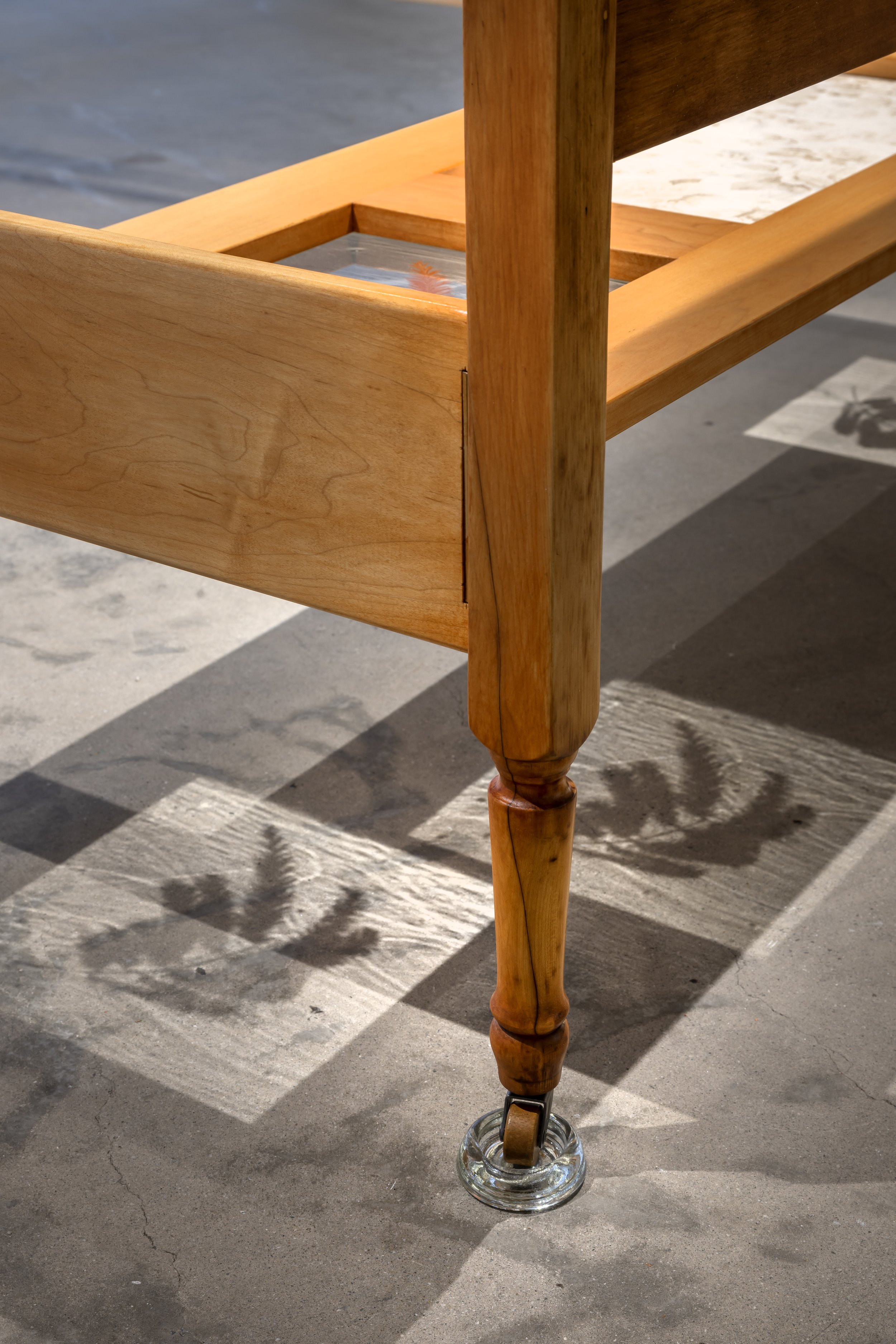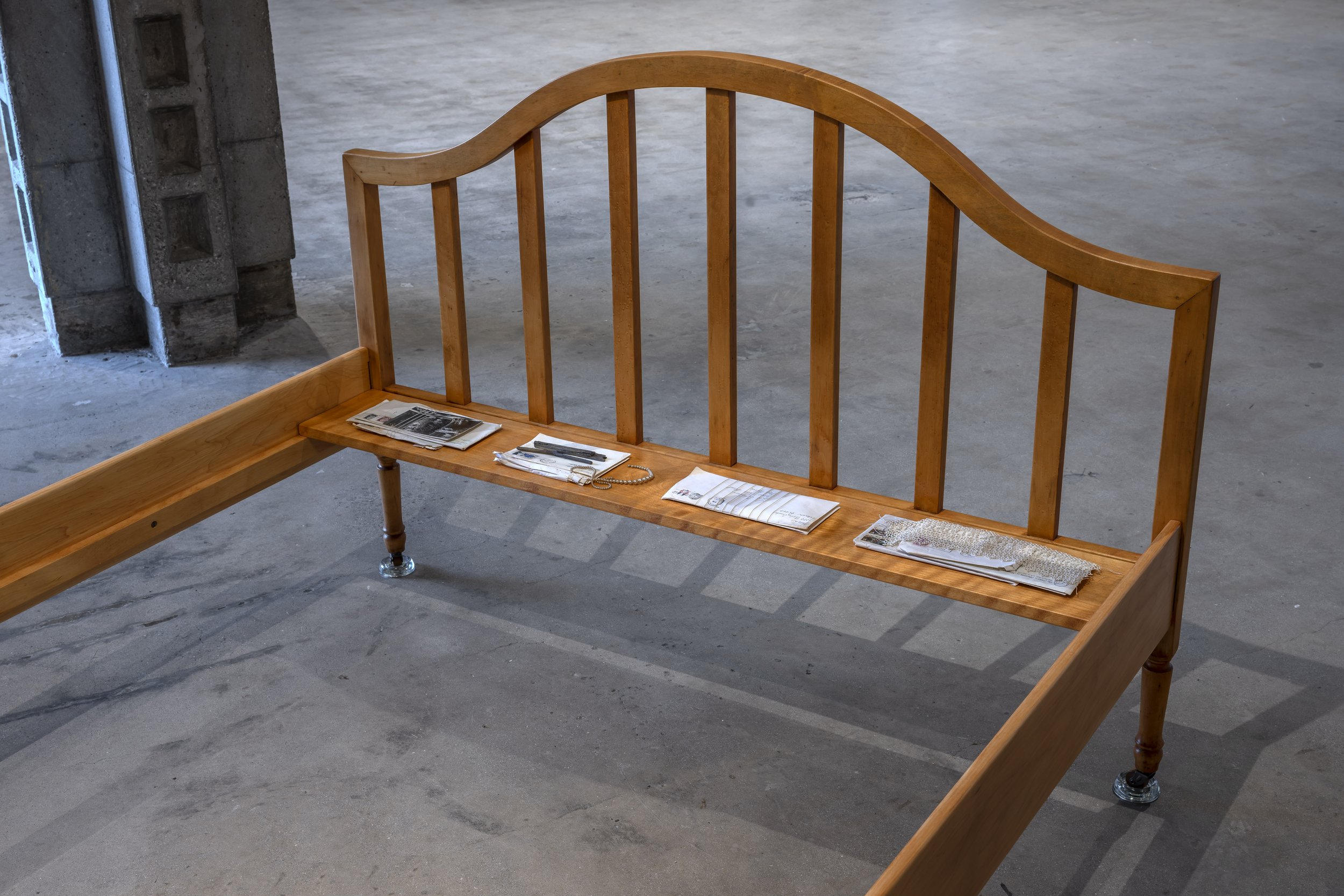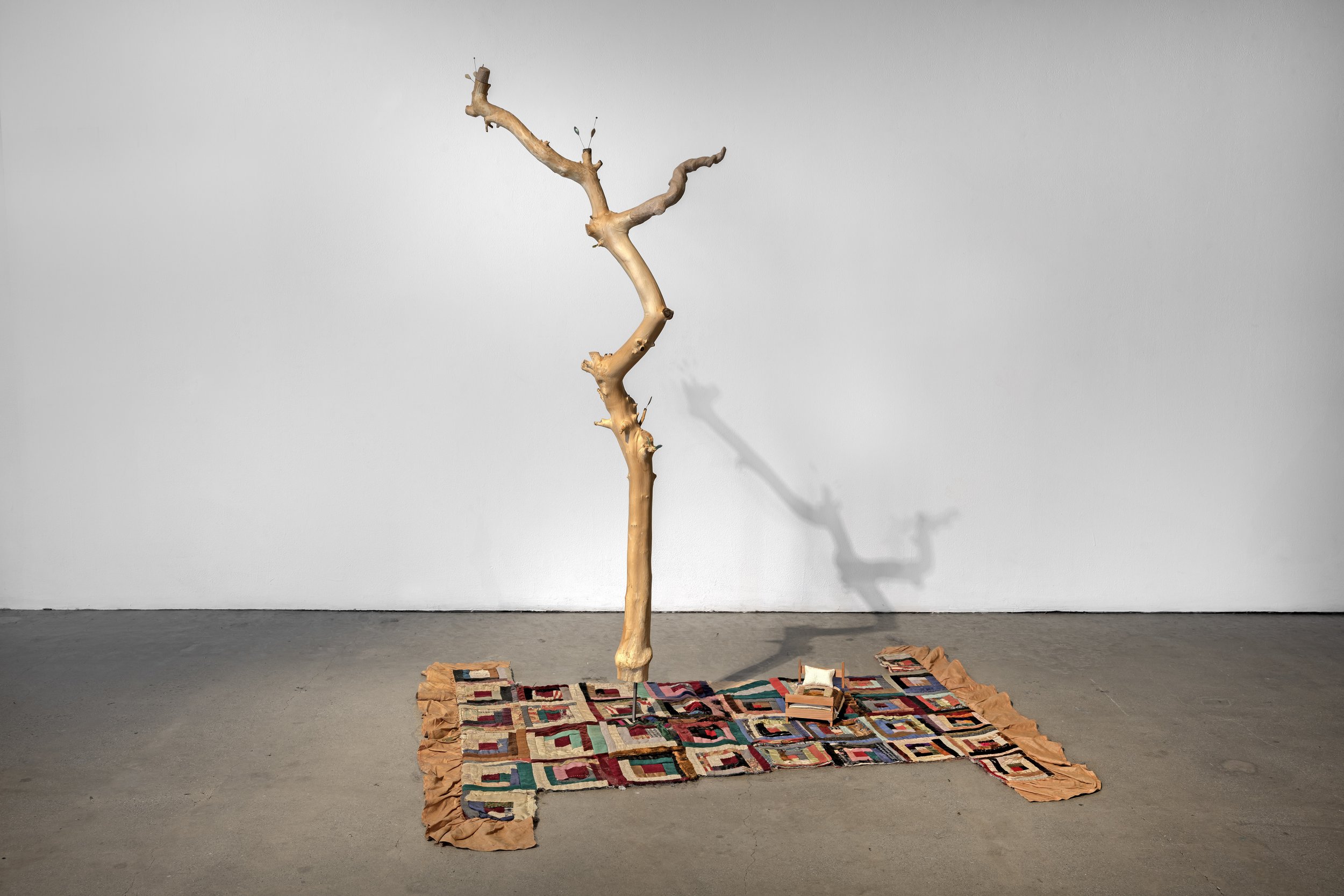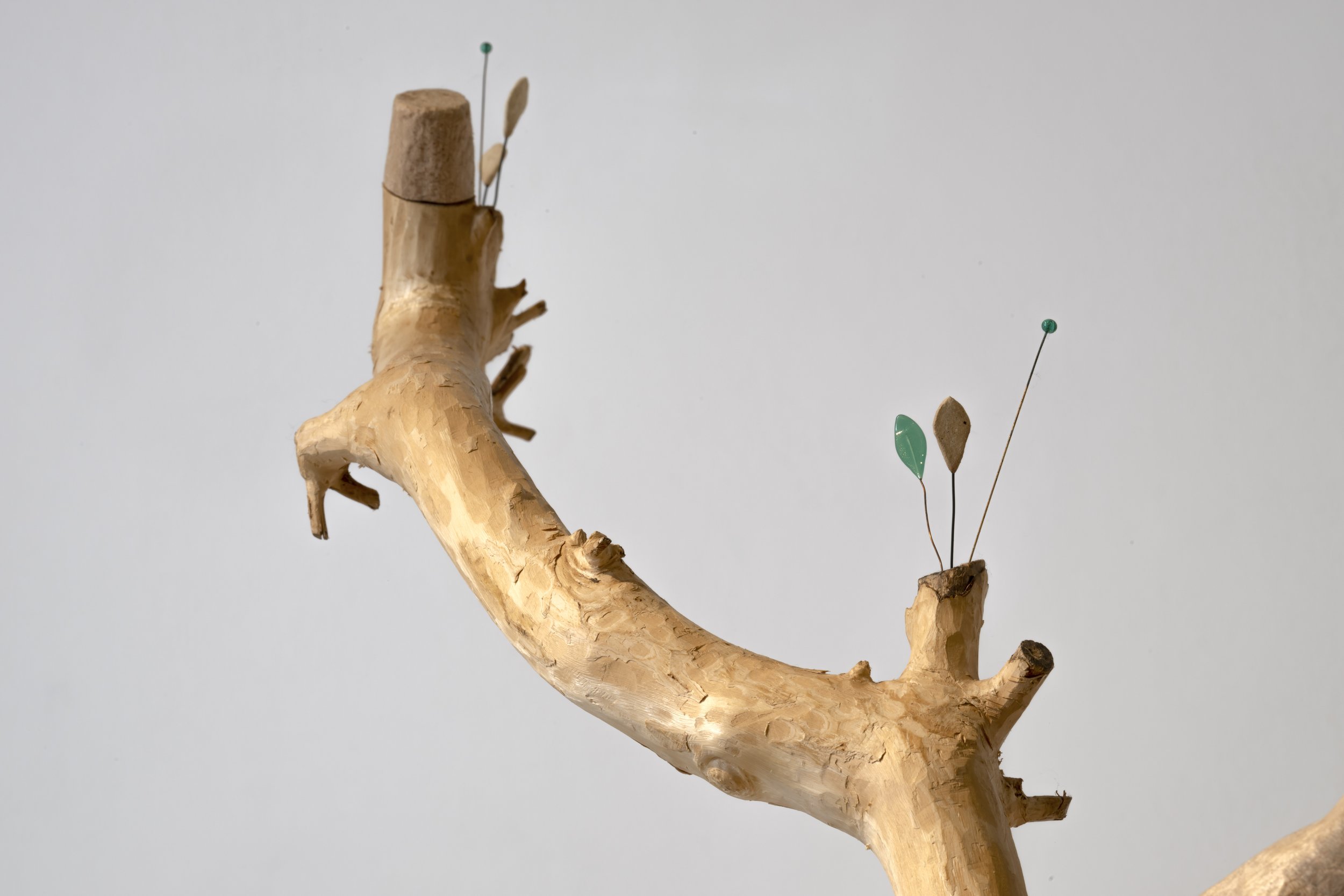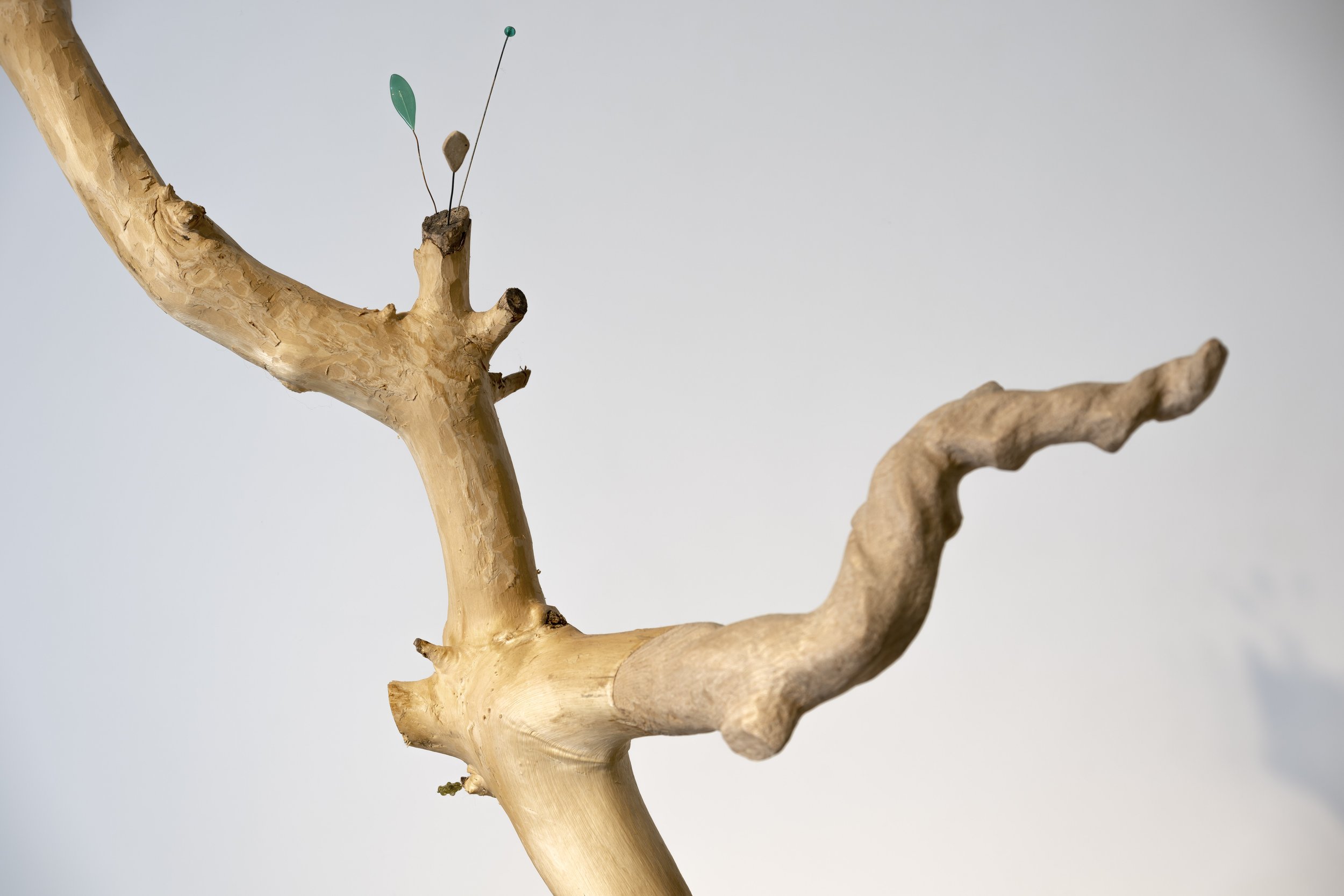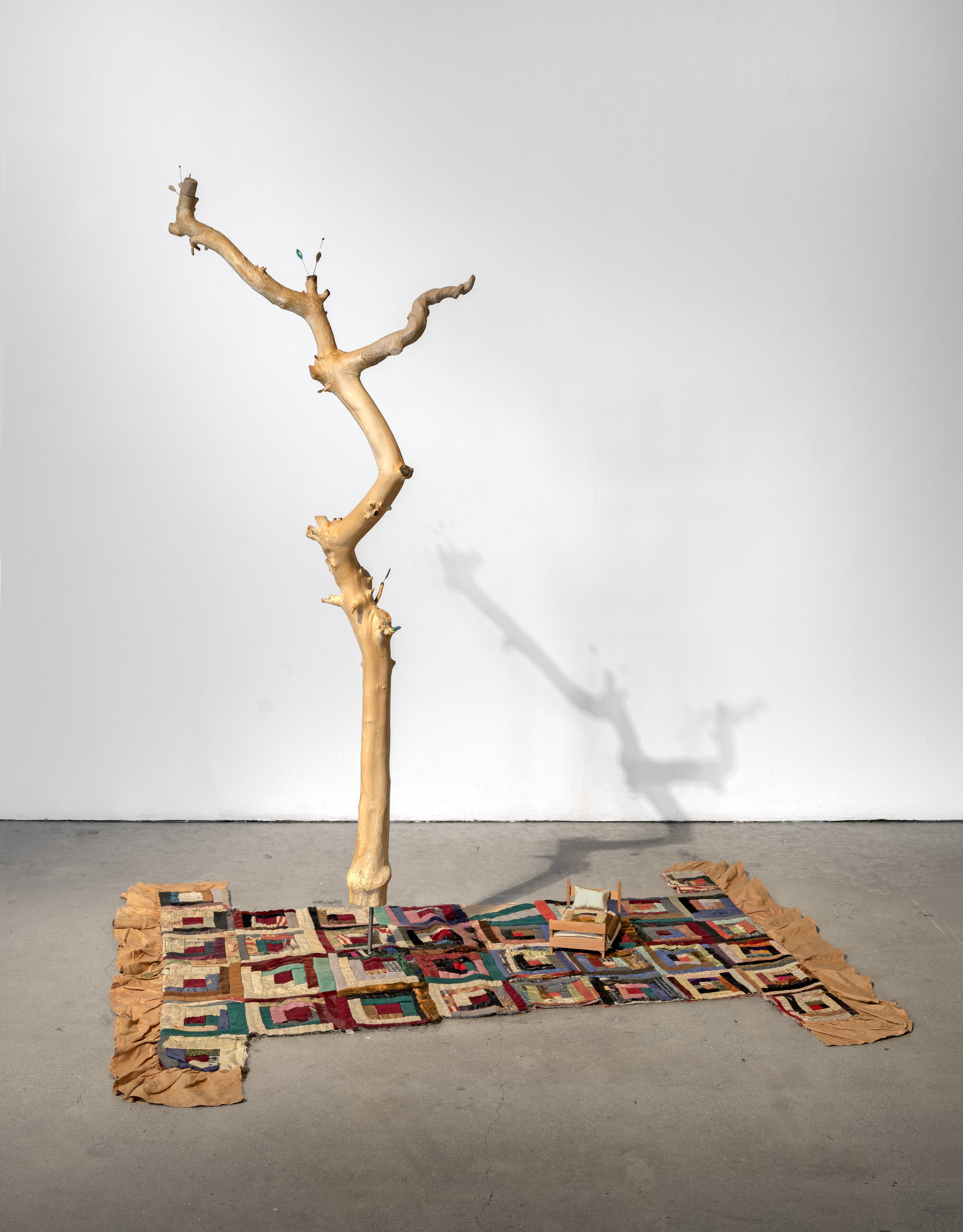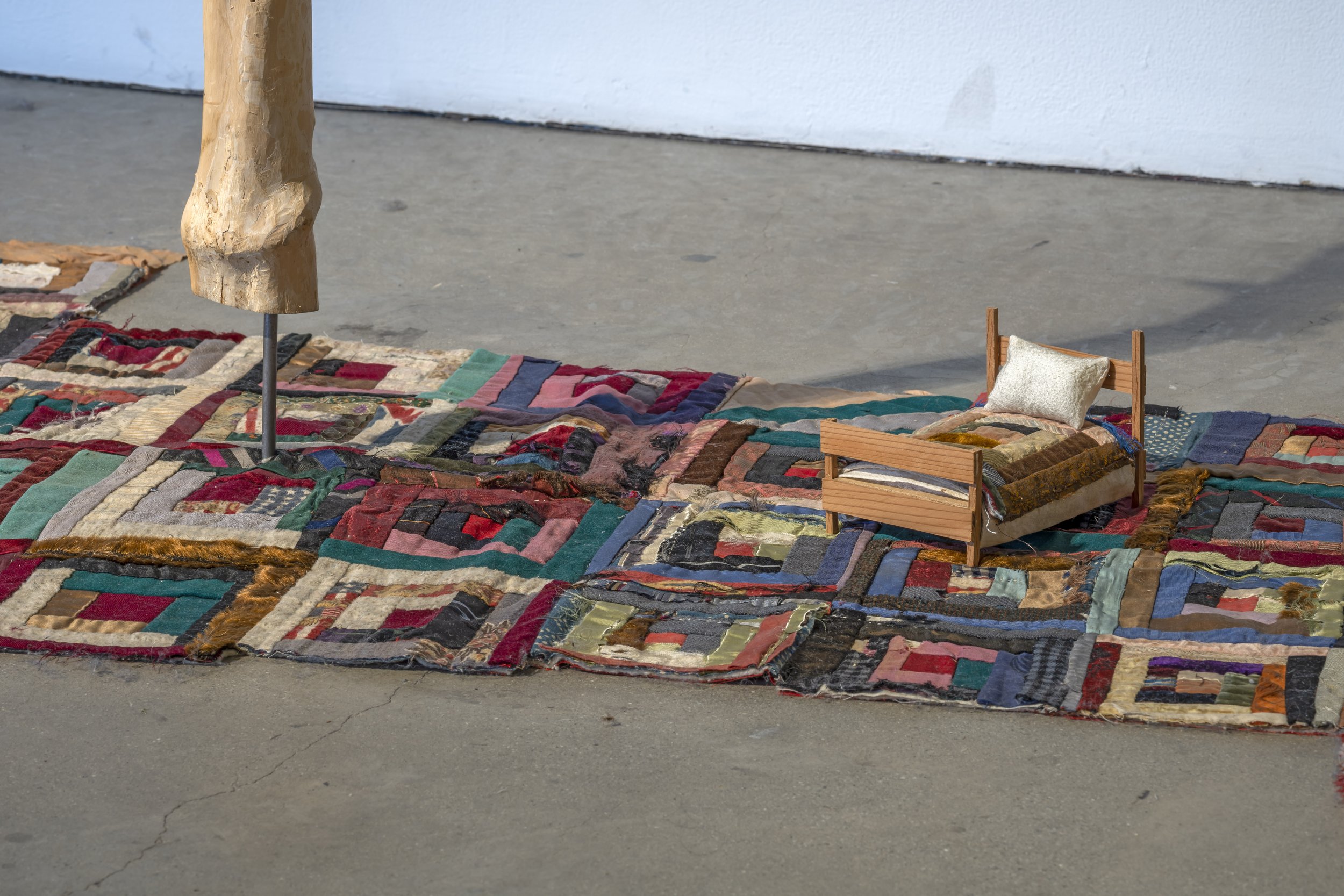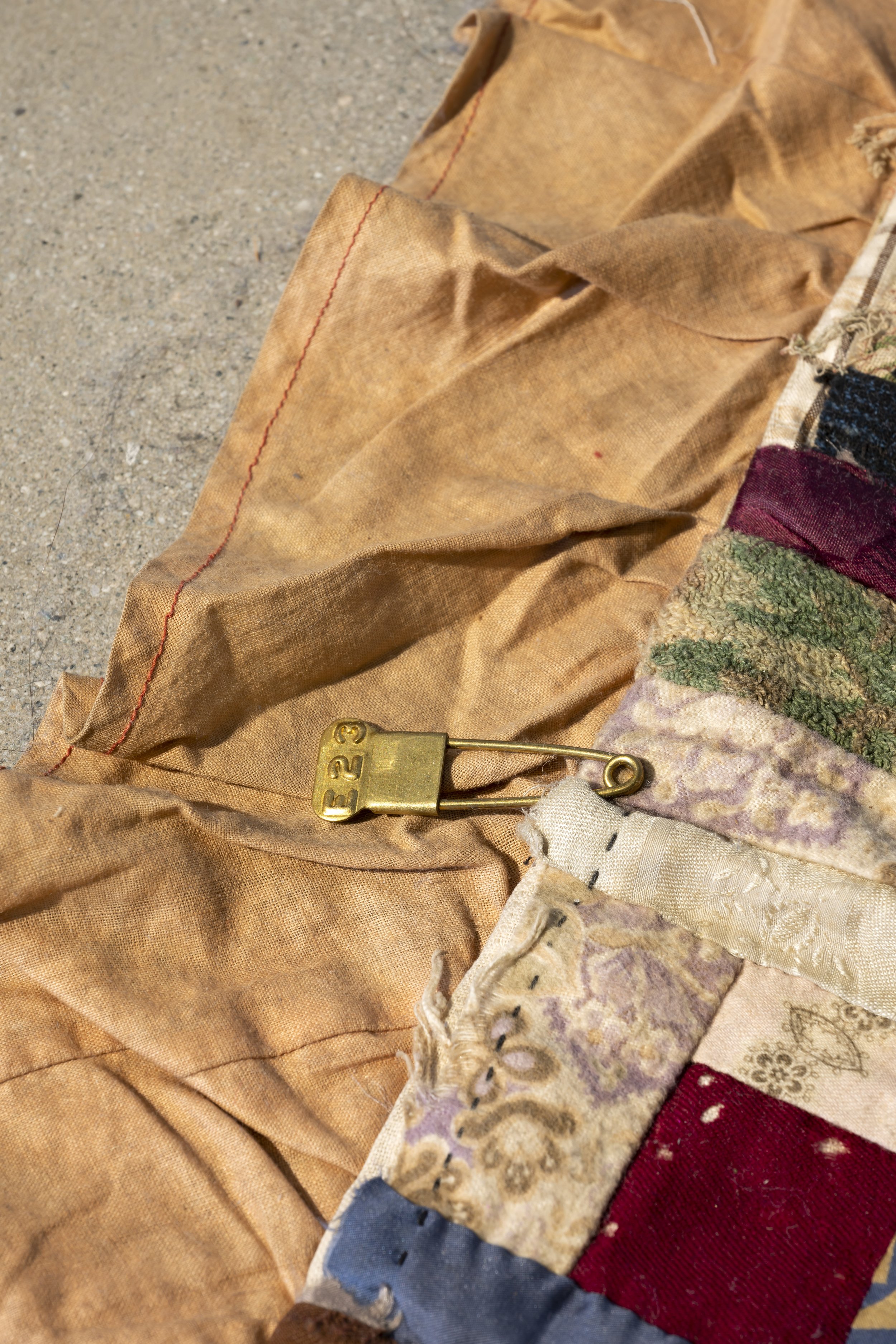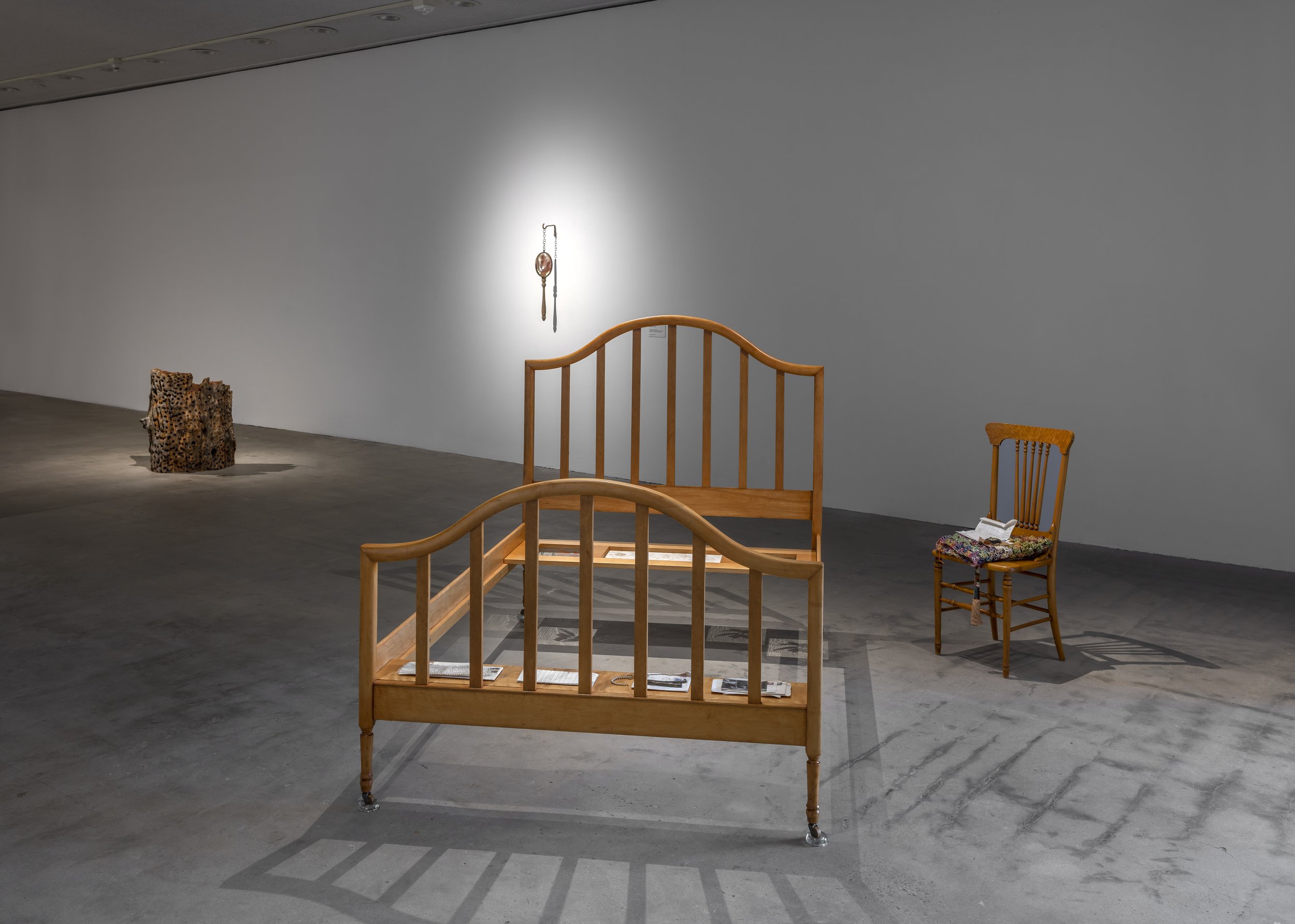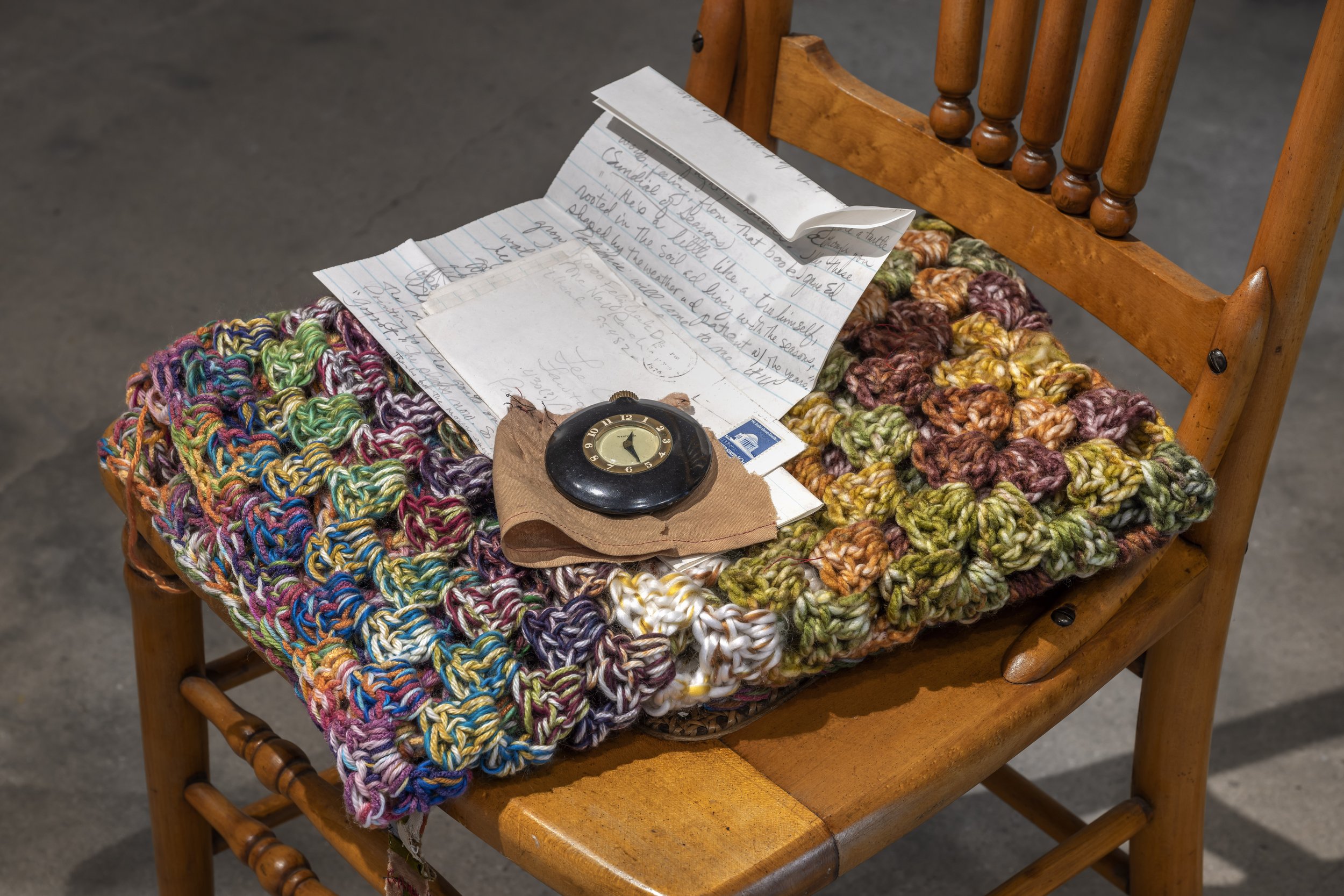A portrait of environmental activist Meca Wawona, Bed (rest) is a suite of ten works became a reflection on the process of aging, including its effect on connection and closeness. These sculptural pieces and a collection of poems and mirror works ask the audience to consider nature, loss, safety, rest, and stewardship. In a small adjacent room in the exhibition, attendees could select typed, original poems that the artist printed on lined cards from a set of vintage recipe boxes, or choose to hold a traditional hand mirror with a written part of the poems, creating a format for looking and thinking. Glass elements throughout the works feature patterns of redwood leaves and silver stain demonstrating traditional painting techniques on antique glass. Handmade 19th century quilt, Meca Wawona’s pillowcase, postcards and letters referring to the fight for California’s redwoods and documenting the challenges of a utopian life as a single mother in the 1970s provide a textural and textual foundation. Throughout the installation, the constantly changing scale challenged the viewer’s point of view. Scale oscillates from small to large: a dollhouse-size bed, a full-size bed frame and chair, a tiny fireplace, or a giant tree top from a fallen Redwood tree.
Founded in 1997, the City of Los Angeles Independent Master Artist Project (COLA IMAP) is an annual grant awarded by the Department of Cultural Affairs (DCA) to a selection of the City’s most exemplary mid-career artists to support the creation of new works. As a recipient of this award in 2024, Brucker received funding to create works for exhibition at the Los Angeles Municipal Art Gallery (LAMAG) at Barnsdall Art Park. A performance, Mirror, accompanied the exhibition.
Photo credits: Gene Ogami.
Jane Brucker, Hand Mirror for Meca, antique matte painted glass, antique stained glass, hammered brass, wood, chain and hanger, approx. 8 x 17 x 0.5 in., 2024.
Hand Mirror for Meca
The act of looking and seeing, along with the ambiguities of safety and viewpoint, complicate the act of observing and resting in Brucker’s work for this exhibition. Family loss is present in this suite of works, focusing on Brucker’s sister-in-law, the environmental activist and homesteader Meca Wawona, who today suffers from Alzheimer’s disease. Founder of the California Conservation Corps, Wawona’s efforts leave legacy and absence. This is not dissimilar to the tension created between space and object in Brucker’s installation.
When the viewer encounters the work Hand Mirror for Meca the painted glass mirror’s shifting translucence and transparency, plays with the typical reflective qualities of a mirror. Instead of the self, the viewer sees layers of traditional stained glass painting. Each layer contains painted redwood leaves and the traditional gold of applied silver stain, their color and pattern diffusing light through the glass layers—preventing one from actually seeing a reflection of one’s self. Instead, one sees through to the visible invisible and the future unknown. The experience is not then a reflection at all, but a kind of ethereal encounter with nature and a sense of a dissolving self.
Meca Wawona in front of a ten-foot diameter old growth redwood cut by Georgia Pacific as part of a 160-acre virgin growth clear cut adjoining Jackson State Forest in 1975. Photo by Nicholas Wilson.
Jane Brucker, Hand Mirror for Meca, antique matte painted glass, antique stained glass, hammered brass, wood, chain and hanger, approx. 8 x 17 x 0.5 in., 2024.
Jane Brucker, Redwood Snag Spring, top of a recently fallen Coastal redwood tree from the artist’s family farm in Northern California, heirloom bird salt and pepper shakers, wood shelves, 32 x 27 x 16 in., 2024.
Redwood Snag Spring
Jane Brucker's Redwood Snag Spring is a poignant meditation on memory and decay. The tree was created using the top of a fallen 12-foot diameter redwood tree as both medium and metaphor. The tree, a long-standing dead tree on Brucker’s brother’s ranch where a spring ran continually from its hollow trunk. When the tree was standing, it was always a familiar landmark and guide on any forest walk. The tree fell over while working on this project, allowing the top section to be cut. It is riddled with holes made by woodpeckers, and evokes the slow erosion of identity and cognition seen in Alzheimer's disease. These holes, natural yet haunting, resemble the voids left in the brain by the illness—gaps where memory, language, and self once lived. Through this organic sculpture, Brucker draws a powerful connection between ecological processes and human vulnerability, transforming the tree into a silent elegy for loss.
A small metallic bird (an heirloom from the artist’s grandmother) rests on the snag. With green and yellow jewels poking from its crown, and violin wire delicately supporting the remains of a wood and silk fan, its presence evokes a hidden secret, perhaps a consciousness at the heart of decay. The tiny scale of the bird, its body hidden as a surprise behind the massive wood base, conveys a sense of the forest—both near and far.
Bed (rest)
In her work Bed (rest), Brucker chose to feature her grandmother’s maple bed, refinished after finding it in her brother’s barn, in disrepair. A wooden frame was constructed to fit into the space where a pillow would normally be placed. Two painted glass panels depicting redwood leaves were inset and a panel of cotton textile pattern showing flowering beige roses repeating across a worn pillow case was placed into the center. The foot of the bed has an additional shelf that holds letters written by a young Meca Wawona to her mother, photographs and postcards featuring Wawona and redwood trees and a pearl necklace.
This work offers a temporary respite from the ravages of ill-health while simultaneously emphasizing that the space where one would most likely rest (on the mattress) is empty.
Jane Brucker, Bed (rest), the artist’s grandmother’s restored maple bed, antique matte painted glass, heirloom linens, and other heirloom materials, 56 x 56 x 78 in., 2024.
Family Tree
Family Tree is a spatial representation of the relationships between family members across different generations, both known and unknown. Here the materials used create a bond between past and present including a civil war era quilt, a lemon tree, carved wooden elements and a tiny bed. The tree itself was created by carving a small lemon tree that had to be removed from a house the artist lived in. Additional branches were hand carved from a wooden rifle stock and miniature handmade glass and ceramic buds and leaves were added. Under the tree a fabric patchwork of parents, grandparents, and even more distant ancestors create the ground from which identity grows. A tiny bed, carefully covered with quilted bedding is both protected and overwhelmed by the curving tree, while camouflaged by the matching quilt patterns. Within the space, this piece created a visual bridge with Bed (rest) and Blanket Chair.
Jane Brucker, Family Tree, the artist’s grandmother’s restored maple bed, antique matte painted glass, heirloom linens, and other heirloom materials, approx. 59 x 28 x 16 in., 2024.
Crucible
Crucible is a wall piece that evokes themes of transformation, memory, and elemental tension. At its center, between two antique bronze corbels, there is a small, flickering campfire. The tiny fire is conjured, not by a real flame, but by code—a delicate choreography of LED lights programmed via an Arduino microcontroller. The Arduino-powered LED flame flickers convincingly, creating the illusion of heat and life without combustion, referencing both innovation and the fading of older ways.
The two corbels are attached so that they face inward, and their patinated surfaces hint at age, weight, and tradition. Their placement suggests both support and reverence, as if they are guardians of the flame or relics of a lost hearth.
Crucible speaks to the collision of eras—where permanence meets impermanence and where memory and artifice are now indistinguishable. The piece invites viewers to consider what we preserve, how we transform ourselves and our stories. It suggests that the line between what is genuinely remembered and what has been constructed or fabricated has blurred so much that distinguishing between the two is no longer possible. It means we may no longer be able to tell what's a genuine memory and what's a convincing fabrication.
Jane Brucker, Crucible, heirloom cast bronze mantel corbels, and heirloom materials, Arduino computer and led lights, 17 x 17 x 7 in., 2024.
Mirrors
The repeated use of mirrors allows for playing with reflection and its absence. The set of handmirrors on display in a separate alcove, is a collection—normally encountered as an individual object—but here assembled to prompt reflection on material memory and the affective dimensions of loss. Each of the mirrors is etched with an excerpt from one of Meca’s letters or a line from one of Brucker’s poems.
One handmirror includes the etched handwritten phrase “It's been a long time..” The cursive letters are taken from Meca Wawona’s own handwriting.
Jane Brucker, Mirrors, set of hand mirrors, 2021-2024.
Blanket Chair
This piece, a partner piece to both Family Tree and Bed (rest), honors Meca Wawona as a founding figure of the California Conservation Corps and a longtime innovative forestry advocate and a proponent of wildlife protection.
The vacant chair and knit blanket evoke care, resilience, and the quiet labor of stewardship. A large pocket watch symbolizes both the urgency and enduring commitment of Wawona’s conservation efforts, though the watch has also stopped. The handwritten letter offers a personal echo of her voice—a reminder that activism is as much about presence as it is about persistence.
Meca Wawona was a chosen delegate to the Clinton administration's Northwest Forest Summit in 1993. The summit aimed to resolve a long-standing conflict over logging in the Pacific Northwest, particularly the impact of old-growth logging on the northern spotted owl and other species. Bringing together various stakeholders–government officials, timber industry representatives, and environmental advocates–the delegates met to find a solution. It resulted in the Northwest Forest Plan, which set aside millions of acres of federal land for conservation and established rules for forest management. This plan is considered a landmark achievement in ecosystem management and biodiversity conservation.
Jane Brucker, Blanket Chair, the artist’s grandmother’s maple chair, and heirloom quilts and blankets, 2024.
Still image and some text from news coverage, Meca Wawona Speaking at Northwest Forest Summit, C-SPAN, 1993.
Mirror (performance)
Mirror is a 40-minute immersive performance created by Jane Brucker as part of the City of Los Angeles Independent Master Artist Project (COLA IMAP) award. Designed to explore the slow, temporal nature of memory, the piece invites audiences to engage in reflection and contemplation.
Seated in a circle, participants witness a quiet unfolding of personal and collective histories. Each performance featured a different audience, leading to unique experiences shaped by those present. Audience members were invited to hold a handheld mirror created specifically for the exhibition. Etched messages, such as “With all my experience I should grow roots,” and “As we near the end of things maybe we should reflect," on the surface of each mirror prompted a response from the audience participant.
At the heart of the work is the story of Meca Wawona, a devoted environmental activist in her 70s who was diagnosed with Alzheimer’s over a decade ago. Her journey formed a poignant and relatable backdrop to the sculptural elements of the exhibition.
Sound and movement—crafted by lead dance and vocal collaborators Jeremy Hahn and SkyE—provided a continuous non-verbal script. This sensitive interplay between bodies, space, and Brucker’s spoken narrative and sculptural works created an environment for shared reflection on aging, illness, memory, and peace.
Jane Brucker’s Mirror, with Jeremy Hahn (pictured) and SkyE, Los Angeles Municipal Gallery at Barnsdall Art Park, Los Angeles, California, 2024.
COLA ’24 Catalogue
“Brucker’s artworks are quiet mementos to lost time, reconcieved for intimate contemplation in the here and now. They invoke the shadows of things past, reminding us that lives and identities are built on shifting ground in a constantly changing world.”
- Writer and art historian Dr. Claudia Bohn-Spector, who wrote about Brucker in the COLA IMAP Design and Visual Artists Exhibition catalogue, City of LA Individual Master Artist Project, LA Department of Cultural Affairs, LAMAG, Los Angeles, CA.
COLA ’24 Gallery Guide
EXCERPT from curator, Nancy Meyer’s interview with Jane Brucker on the occasion of the COLA ’24 Exhibition:
Nancy Meyer: Can you discuss the importance of adding to/revisiting certain bodies of work and how that relates to your practice overall?:
Jane Brucker: Time moves slowly, and chances are that in my lifetime, I will repeatedly explore the same ideas. My colleague Paul Harris has called my work “cumulative and incremental.” I think this is correct. Ongoing work can be adapted to new spatial opportunities, or move me deeper into the content and I never really get tired of it.
An example in COLA 24 is Bed (rest). It builds off of my series, Spiritual Furniture, the title of which was inspired by one of my theology professors, Dr. Jack Coogan. During my study, I was going through an existentially difficult time and was late turning in a paper. When I explained my situation to him, he said to me, “That is understandable Jane, you are moving a lot of spiritual furniture around.”
Promise of Paradise
KZYX Episode 7: Meca Wawona
Radio broadcast interview recording with Meca Wawona
Mendocino County Public Broadcasting
By Kate Magruder
Published December 27, 2018 at 3:06 PM PST
Meca Wawona, a tireless environmental activist and homesteader who was instrumental in founding the California Conservation Corps on the philosophy of humanity working in concert with nature, rather than in the "Man versus Nature" mode she saw at the time. Wawona homesteaded on McNab Ranch, then at Greenfield, where she inculcated the next generation with the values that were so precious to her. (Text from KZYX)

